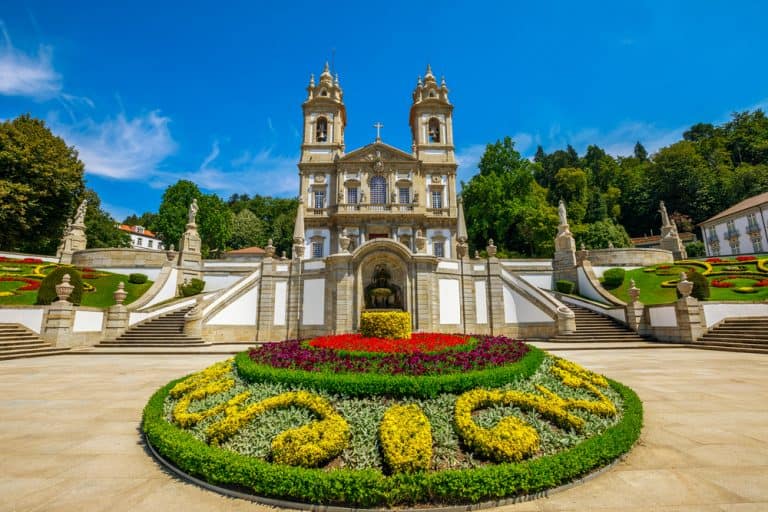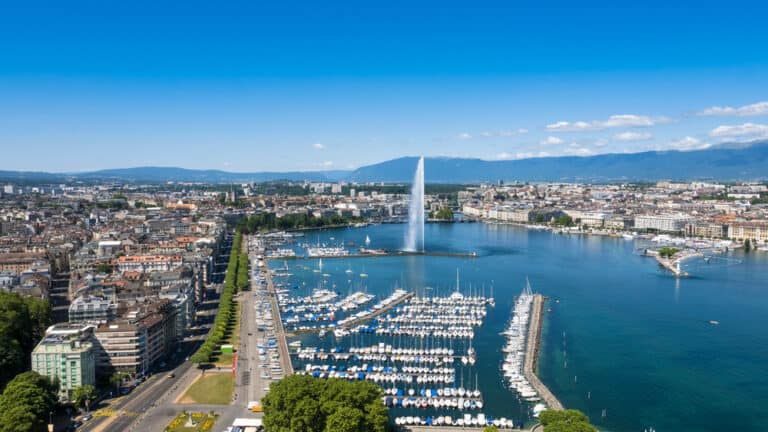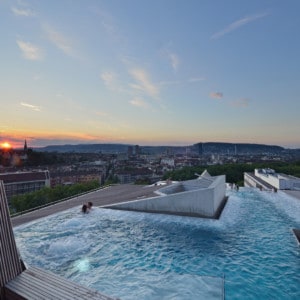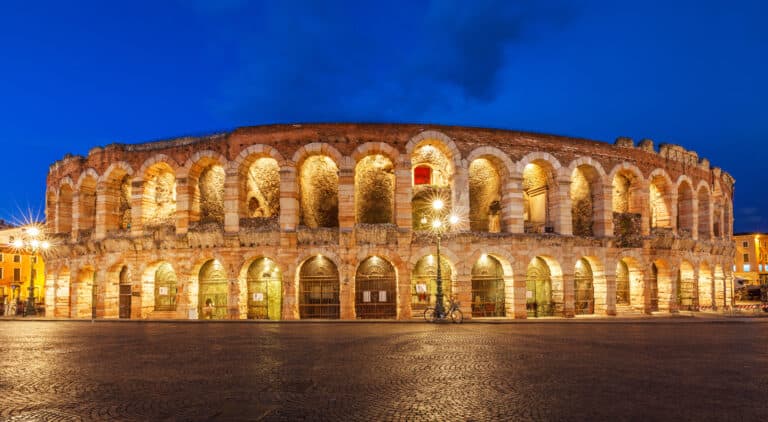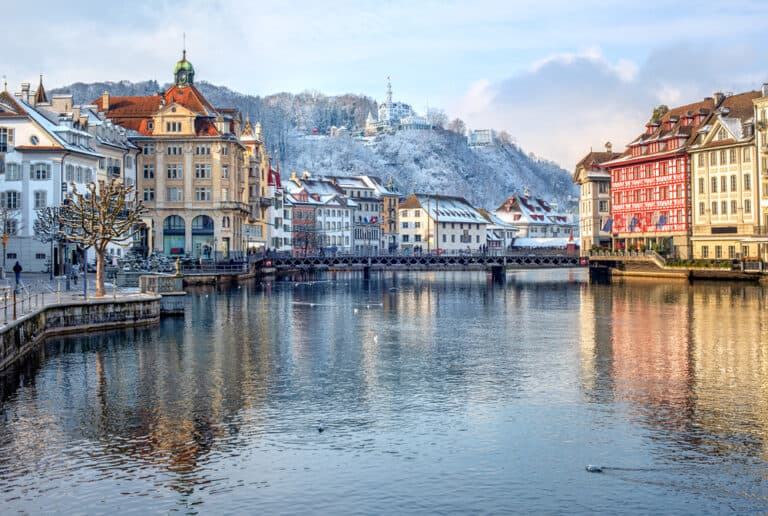Top Europe city breaks – that aren’t capital cities!

If you’re looking to choose a Europe city break, you may be a bit overwhelmed by the choices on offer.
There are 44 countries in Europe, all home to lots of fabulous destinations: there are large modern cities, medieval ones, smaller coastal resorts, and places sat on alpine lakes. All offer a unique blend of history, culture, scenery, and culinary delights.
When deciding where to go, you might opt to go to the capital cities. There are some undoubtedly fantastic capitals in Europe and I’ve been to some of these including Lisbon, Bern, Berlin, Bratislava, Valletta, Brussels, and Edinburgh.
But you might want to go to a different type of city: a city that’s a bit smaller and easier to get around in just a few days or on a day trip; a city that more conveniently located; or a city that has a particular sight you want to visit.
Below I have listed 10 of the top cities we’ve recently visited that aren’t capital cities. They are cities that have lots of sights to see and lots of reasons to visit. You can also find other ideas for some of the best European city breaks here.
This post contains affiliate links
Milan, Italy
Milan, Italy’s second-largest city, is a fabulous destination. Situated in the north of the country, it has a fascinating history, numerous attractions, and a world-renowned fashion scene. It’s a place that has something for everyone.
Based on my recent trip here, I have a post that gives you an itinerary for 2 days in Milan. It outlines the best things to do in Milan. It also gives you some ideas for other things to do if you have more time and can take a day trip out of the city.
My itinerary suggests you start at the Piazza del Duomo. Here, you can visit the Duomo – a gigantic church that you need to stop and stare at for a while to take in its impressive architecture. It is the largest church in Italy and one of the top Milan attractions.

You can go inside, walk around its massive interior (apparently up to 40,000 people can fit inside), and go to the rooftop. I’d recommend doing both: if you don’t want to climb the 250 steps to the roof, you can take a lift. This gives you the chance to walk around the sides of the roof and see the detail in the spires and statues here, as well as actually climb onto the rooftop. There are wonderful views from up here.

Just across the square from the Duomo is the Galleria Vittoria Emanuele II, a neo-Renaissance structure with an eye-catching glass-domed roof. You can wander through this, taking a look at the high-end shops. You can then come out the other end to see the famous Teatro alla Scala opera house.
The Leonardi 3 World of Leonardo da Vinci museum is also in the square here. This museum is a must if you want to learn more about the life and work of one of the city’s most famous son’s Leonardo da Vinci.
There are also other places where you can see some of his work, most significantly in the Santa Maria delle Grazie church where the ‘Last Supper’ can be viewed painted onto a wall. This is regarded as one of the world’s most famous works of art, so it’s not surprising that you need to book to see it several weeks in advance.
Other top places to visit in Milan include the Castello Sforzesco, a large fortress dating back to the second half of the 14th century. Behind this is Parco Sempione, which houses an art and design museum and the Torre Branca tower.
You can also visit the Navigli district, the city’s canal district. Here, you can wander around, soak in the atmosphere, and have an early evening aperitivo.

Geneva, Switzerland
Geneva is Switzerland’s second-largest city. It sits on Lake Geneva (Lac Leman) and is not far from the Swiss Alps and French border. I’ve visited several times and highly recommend it as a top European city break.
It’s a lovely city to explore and is well situated for days out to other nearby places. Even if you only have one day, you can still fit in a lot of the top things to do in Geneva – sign up for my itinerary for one day in Geneva here.
In the city itself, you should spend some time in the old town wandering around its quaint streets and historic buildings. At night, it is lit up and has a lively atmosphere.
While in the old town you should visit the Cathedral of Saint-Pierre. This has an interesting history, having been founded in the 4th century as a Roman Catholic cathedral and then converting to being Protestant during the Reformation. If you go inside, you can see the chair used by the Protestant Reformer, John Calvin (this was smaller than I imagined it would be!).
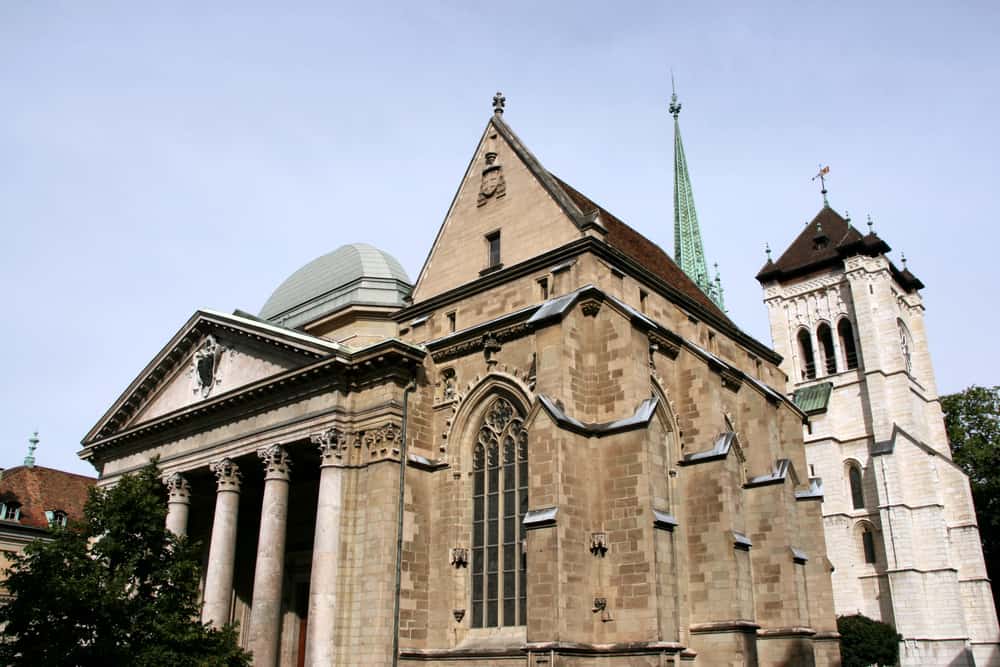
If this interests you, you can also go to the Parc des Bastions to see the Reformation Wall. This massive monument commemorates the leading figures of the Reformation, including Calvin. The park is also a pleasant place to wander around, especially if the weather is fine.
Aside from the old town, I’d recommend spending time by the lake. You can walk along the lakeside promenade or take a boat trip.
If you don’t want to book a lengthy trip on the water, you can just hop on one of the Mouettes Genevoises, the little yellow public boats which take you across the water to different parts of the city in just a few minutes. If you’re staying in the city and have the Geneva Transport Card – ask you accommodation for one – you can hop on these for free.
They’re a fun way to travel, and a couple of the routes will take you past the Jet D’Eau, a 140 metre-high water jet that is visible all over the city and one of the most iconic sights in Geneva.

Other Geneva attractions include the Palais des Nations, the former headquarters of the League of Nations. This has a massive sculpture of a broken chair nearby which “symbolises the campaign against landmines”. In keeping with this, the city also houses the International Red Cross and Red Crescent Museum.
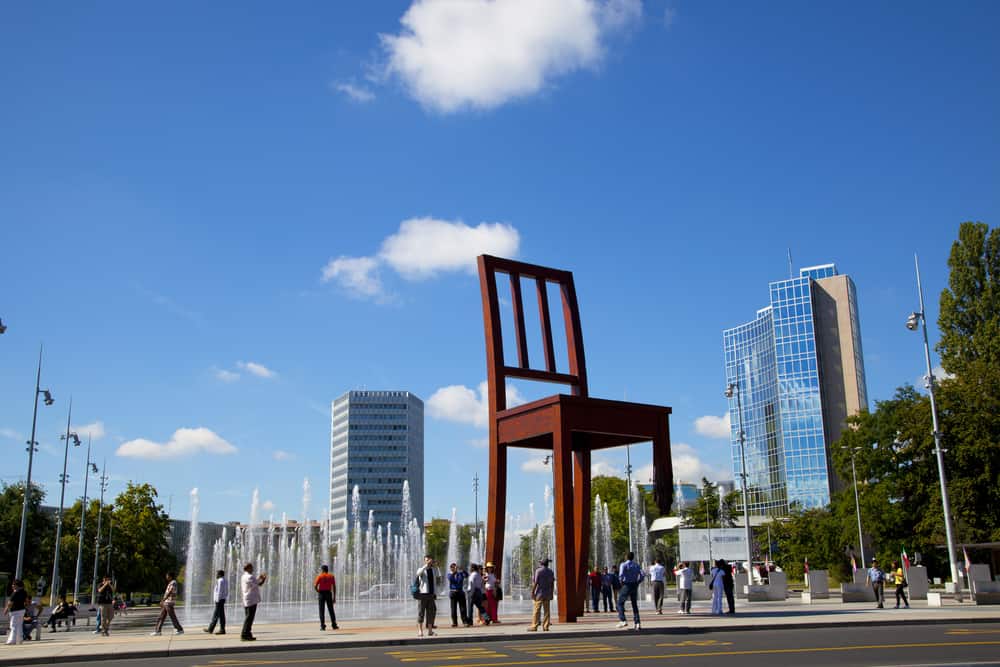
Geneva also has a range of other museums, and a botanic garden. It is also within easy reach of other fabulous places along Lake Geneva, such as Lausanne and Montreux, so it’s easy to fit in visiting other places on a Geneva city break. There are also nearby mountains if you fancy going hiking or skiing.
Porto, Portugal
Porto is one of my favourite cities in Europe. Portugal’s second city, located in the north of the country and on the Douro River, is a fabulous place for a city break. It’s famous for its port wines and while a tasting session at one of the city’s renowned port lodges is worth doing, there is also lots more things to do in Porto.
It’s historic centre is a designated UNESCO World Heritage Site. Part of this includes a hilltop complex that contains the Se do Porto, the city’s 12th century cathedral.

The cathedral stands in a large square from which there are sweeping views of the city and the iconic Ponte de Dom Luis I suspension bridge.
You can also take a tour inside the Episcopal Palace. From here, it’s then only a few minutes’ walk to the central Plaza, Praca da Liberdade) with Porto’s town hall.
You can also head to the Torre des Clerigos, a 76 metre high tower that you can climb. If you do decide to do this, walk via Rua dos Clerigos and try Portugal’s famous tart, the pastel de nata. The Manteigaria bakery serves these piping hot from the oven. Believe me, they are worth the stop here!
Also nearby is a treat for Harry Potter lovers. The Livraria Lello is the bookshop that inspired the famous books. You can buy a ticket to pop in and take a look in this neo-gothic shop with its twisting staircase and stained glass sky-light.
Other top things to do in Porto include visiting some of the other churches in the city, some of which have beautifully decorated facades. There are also various museums and a botanical garden that you can include on your Porto itinerary. You can also take a vintage tram to the coast and book a boat trip along the Douro River (for other day trips from Porto, check out my post that lists places to consider).
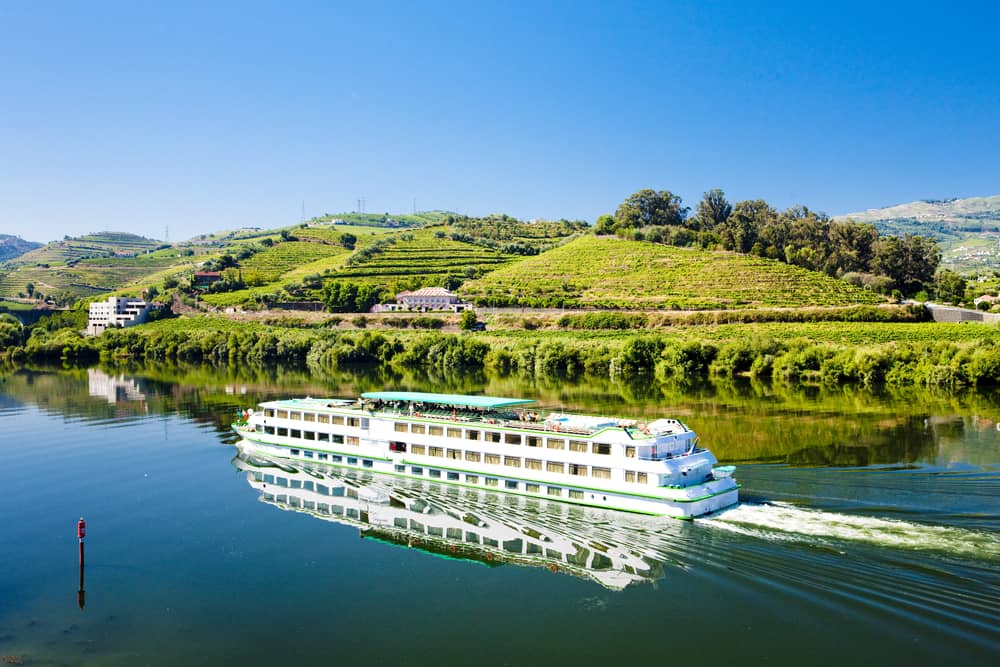
And if you do want to try out that port, you can either visit one of the many bars and restaurants in the riverside area of Rebeira (this area is worth a visit in itself) or go across the river to Vila Nova de Gaia. This is a nice area with old traditional rabello boats moored on the water. Several port lodges and cellars are also here where you can book tasting sessions.

Munich, Germany
The Bavarian capital, Munich (Munchen) is home to historic buildings, excellent museums, spacious parks and gardens, and impressive palaces. And if you’re partial to a German beer or two, you’ll find plenty of options here in the city’s numerous beer halls (not to mention the annual Oktoberfest, which is held in the city).
As a starting point, you will probably naturally gravitate to Marienplatz Square. This square is in the old town and home to some of the city’s most iconic landmarks, including the neo-gothic Neues Rathaus (New Town Hall). Aside from its size and striking architecture, it’s famous for its glockenspiel. This displays a show a couple of times a day which features 43 bells and 32 life-sized figures.
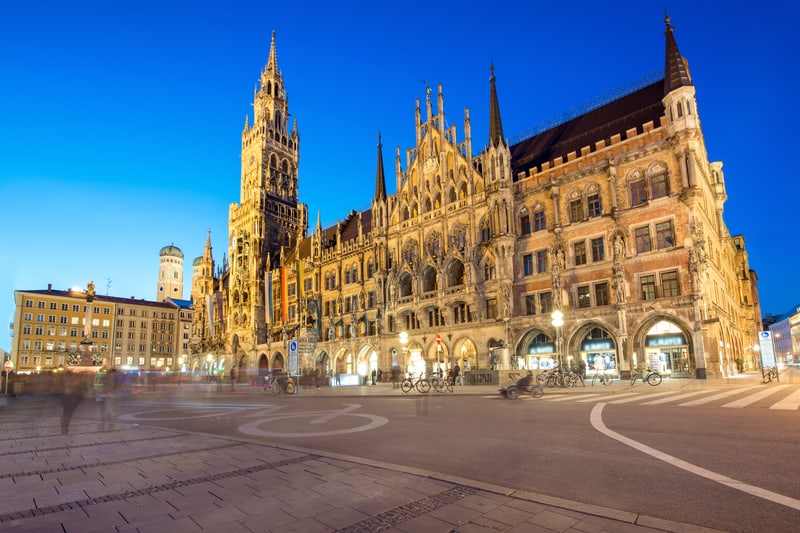
The Altes Rathaus (Old Town Hall) is also in the square. It’s smaller and more modest in design than its newer counterpart and houses a toy museum.
Near the Marienplatz Square is The Residenz – this houses a museum, Treasury, and theatre and was once a royal palace. On the other side is the 15th century Frauenkirche Church with its two domed towers, one of which you can climb.
To get some fresh air, head to the Englischer Garten. This is the largest public park in Munich and worth spending some time in: in fact you’ll need a bit of time to see it as it’s over 370 hectares in size! Within its borders there is a monopteros, a neoclassical temple, and a Chinese Tower/pagoda with a beer garden next to it. The garden also has a lake and river. You can hire a boat or stop and watch some river surfing.

On the outskirts of the city, you can visit the Schloss Nymphenburg. This is a beautiful baroque palace that was built in the 17th century. I’d recommend making the time to go out to this – it doesn’t take long, and the hop on/ hop off bus goes there.
For me, it’s definitely one of the top things to do in Munich. There are several museums here and extensive grounds to wander around. As you do this, you’ll see an array of pretty pavilions, lakes, and a canal where you can ride on a gondola.

The city also has a botanical garden, a zoo, and a range of museums to cater to all sorts of interests (including science and technology, toys, and BMW cars).
Antwerp, Belgium
Belgium’s second city has a great mix of the old and the new and there are lots of things to do in Antwerp. It’s easy to get a feel for all of this on a short trip to the city.
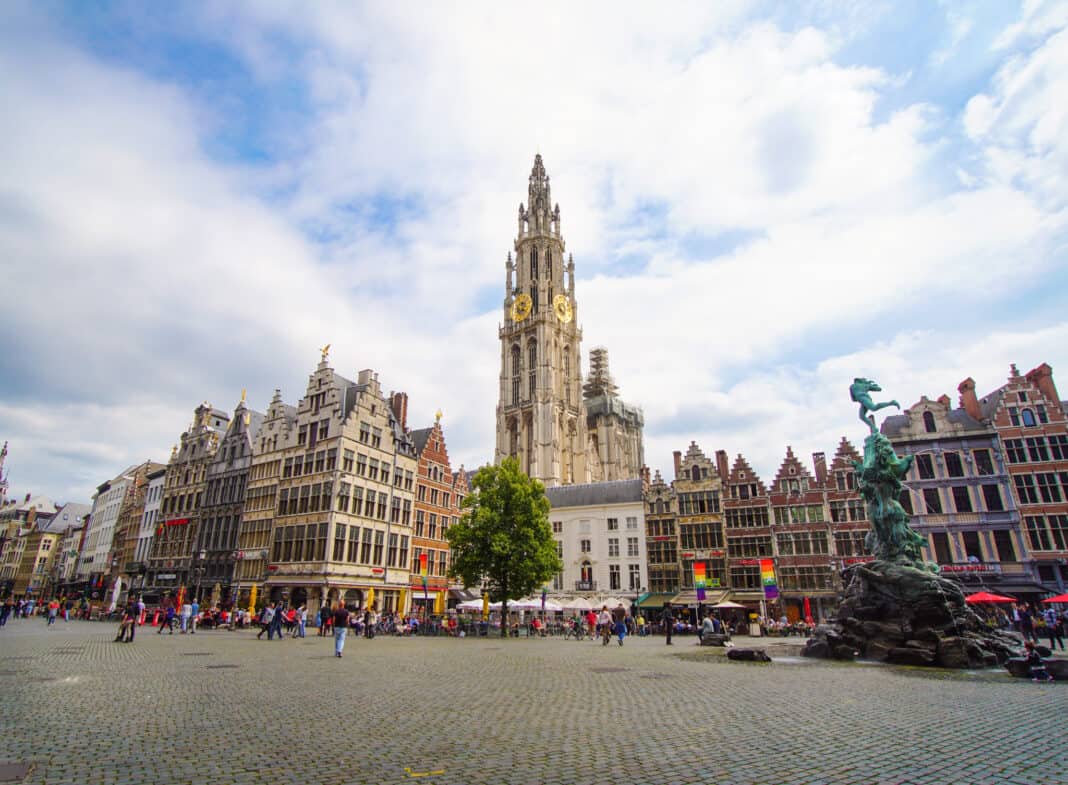
The city has a medieval centre, and lots of the top Antwerp attractions are around here. There is a pedestrianised Grote Markt (market square) dating from the 1200s and many attractive guildhall buildings. The most noteworthy of which is the impressive 16th-century Stadhuis (Antwerp Town Hall).
In the adjacent Handschoenmarkt, there is the spectacular Cathedral of Our Lady (Onze-Lieve-Vrouwenkathedraal). This is one of the defining landmarks on the city’s skyline, thanks to its spire, which takes it to 123 metres high. For a fee, you can go inside and see some paintings by Rubens. You can also try out the cathedral’s beer while on the site!
Antwerp also has a castle! Het Steen is the oldest preserved building in the city. It houses The Antwerp Story, an attraction that provides information on the city, its famous residents, and the museums you can explore.
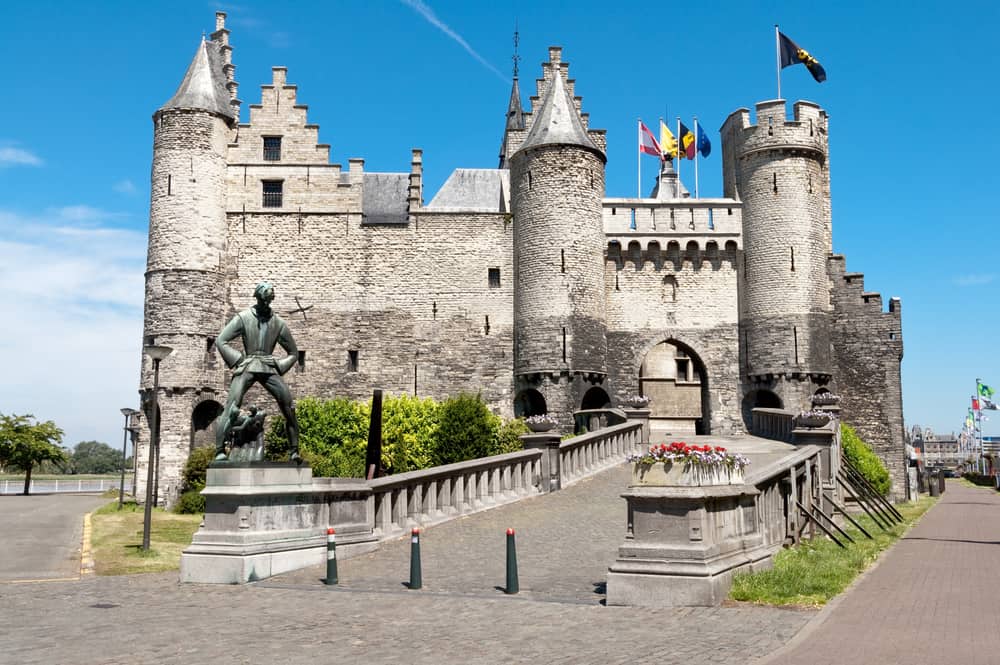
If you like visiting museums, you’ll also find that the city has an impressive array of first-class – and unique – museums. The Museum aan de Stroom is particularly unique: a 10-storey almost cube-like structure with an outside rooftop where you can enjoy spectacular views over the city. Inside is a diverse collection of artistic, cultural and historical artefacts.
Nearby is the Red Star Museum, which focuses on the Red Star shipping line that once had Antwerp as its European port.
There’s also the Museum Plantin-Moretus, the original home and studio of the Plantin-Moretus publishing family and the site of the world’s oldest printing presses. There are also various places where you can view art, a Royal Palace, and an upmarket residential district where you can marvel at stately art nouveau houses.
The city also has a zoo. This is next to Antwerp Centraal Station, itself worth seeing. Dating from the early 1900s, Antwerp Centraal Station is one of the most visually stunning railway station buildings I think you’ll ever see.
Bruges, Belgium
Bruges might not be as big as Antwerp or the capital, Brussels, but it’s still one of the most popular destinations in Belgium. When you visit, it’s not hard to see why. Millions every year are drawn to the city’s picturesque vistas of historic landmarks, cobbled streets, beautiful medieval buildings, and scenic canals.
There’s lots of things to do in Bruges on a short break: historic buildings to see, top-class museums to explore, canal boat trips that give you a chance to see the city from the water, and, of course, chocolate and beer tasting!
The top things to put on your Bruges itinerary include a visit to the central Grote Markt in the heart of the city. Here you’ll find the city’s 13th century belfry tower which is 83 metres high. You can climb to the top of this (note there is no elevator) and take in the views from the top.

The grand Provincial Court is also in the square, as is the Historium Bruges museum, where you can learn more about the city’s history. In Burg Square, there are three notable buildings with some of the finest architecture in Bruges: the City Hall, Palace of the Liberty of Bruges, and the Basilica of the Holy Blood.
After exploring the centre and seeing all the impressive buildings, you can then take in the city from the water and ride along some of the picturesque canals. This is definitely amongst some of the best things to do in Bruges. You’ll go through Rosary Quay, a beautiful spot that is said to be the most photographed spot in Bruges, see the Meestraat Bridge, get views of the Church of Our Lady, and pass under Bonifacius Bridge.

On a Bruges city break, you can also visit a range of different museums (including one dedicated to beer!), the inside of the Church of Our Lady with Michelangelo’s Madonna with Child sculpture, the Minnewater (the Lake of Love), and a 13th century Begijnhof.
Bruges is located in the north of Belgium. It is just an hour’s train journey from Brussels and quite frankly a perfect place for a Europe city break.
Bordeaux, France
Bordeaux is located in south western France near the Atlantic Coast. If you visit for a few days, you’ll find wonderful historic buildings, fabulous museums, and a river to wander along.
The city is also within easy reach of other interesting places if you’re looking to go out and about on day trips. And as the Bordeaux region is one of the top wine regions in France, if not the world, it is a perfect destination for wine lovers.
There are many things to do on a Bordeaux city break – see my 2 day itinerary. It’s also possible to walk between many of the Bordeaux attractions. In fact, walking between the sights and through the various cobblestone streets and pretty squares will give you a real feel for the city.
You’ll see the Pont de Pierre, the city’s first bridge, and the Basilica of Saint-Michel, a gothic UNESCO World Heritage Site. This has a separate free-standing bell tower 370 metres high, which you can climb.
You can also walk through some of the old city gates. One of these – La Gross Cloche (which translates as ‘fat bell’) has a bell that is over 7,700 kilos in weight. And then on the other side is a small coffee shop – Cassonade – where you can stop and try one of the city’s traditional Canneles de Bordeaux. These are small pastry-type cakes filled with custard that are said to have originated back in the 15th century in the local convents.
These will refuel you before you walk onto another city gate, the striking La Port Cailhau.
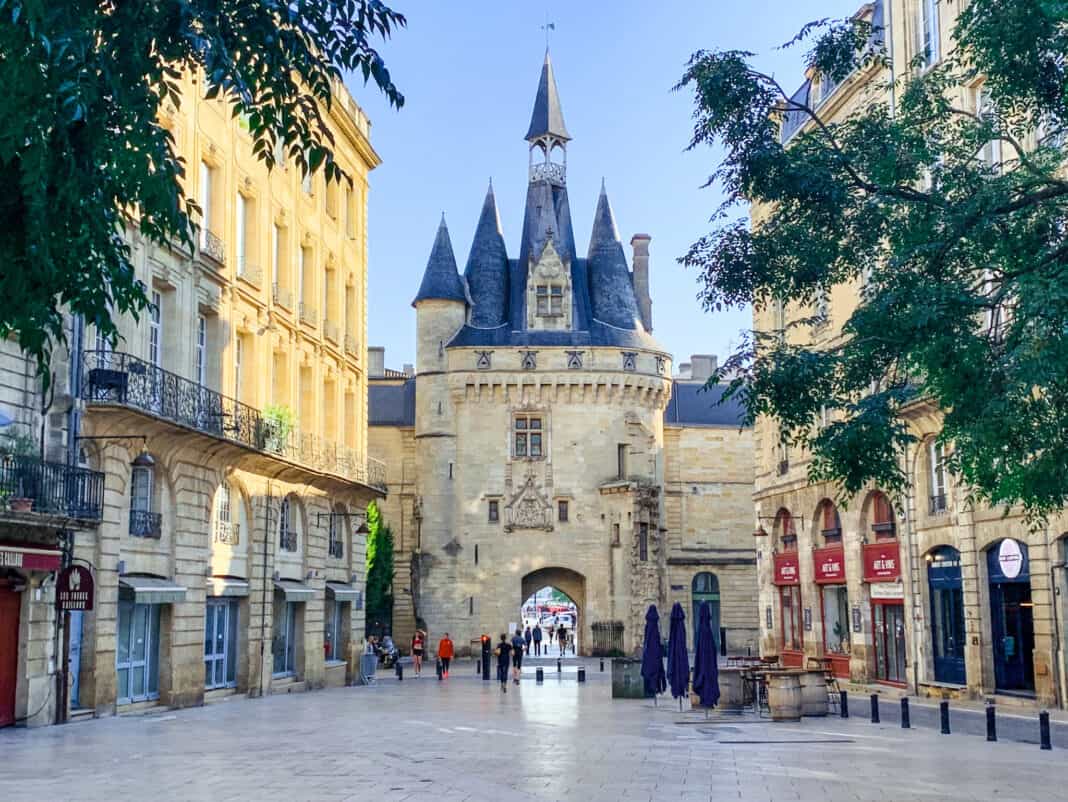
You should then walk on a bit further to the Place de la Bourse with Le Miroir D’Eau. The latter – a water mirror on the ground – is said to be the most photographed sights in Bordeaux. You’ll definitely want to stop and take some photos yourself here – it’s really quite unique and definitely memorable.

Other top things to do in Bordeaux include walking (or maybe even sailing!) along the river – there are restaurants and bars along here – and learning about the region’s famous wines. You can do this in several places, but I’d recommend visiting La Cite du Vin. This museum houses state-of-the-art displays and exhibitions in a futuristic silver tube-like building overlooking the river.
You can also visit the Cathedral Saint-Andre de Bordeaux, the nearby Town Hall, and see the opera house in the Place de la Comedie. The city also has a lovely park to wander around and numerous other museums, including the amazing Les Bassins des Lumieres, a digital arts exhibition in an old submarine base.
Rotterdam, The Netherlands
To first-time visitors, Rotterdam is architecturally like no other Dutch city. A large chunk of the centre was flattened in the early stages of World War II and needed to be rebuilt.
The result is a fascinating blend of impressive modern and cutting-edge architecture with attractive waterfront townhouses that survived the devastation. All this makes for an interesting and fascinating Rotterdam city break.
On a visit to Rotterdam, you can get an idea of what the city looked like before the Nazi invasion in Delfshaven. This is a small and pretty area on the harbour, with bars, restaurants, and a windmill. There is also the De Pelgrim brewery, where you can sample local beer.
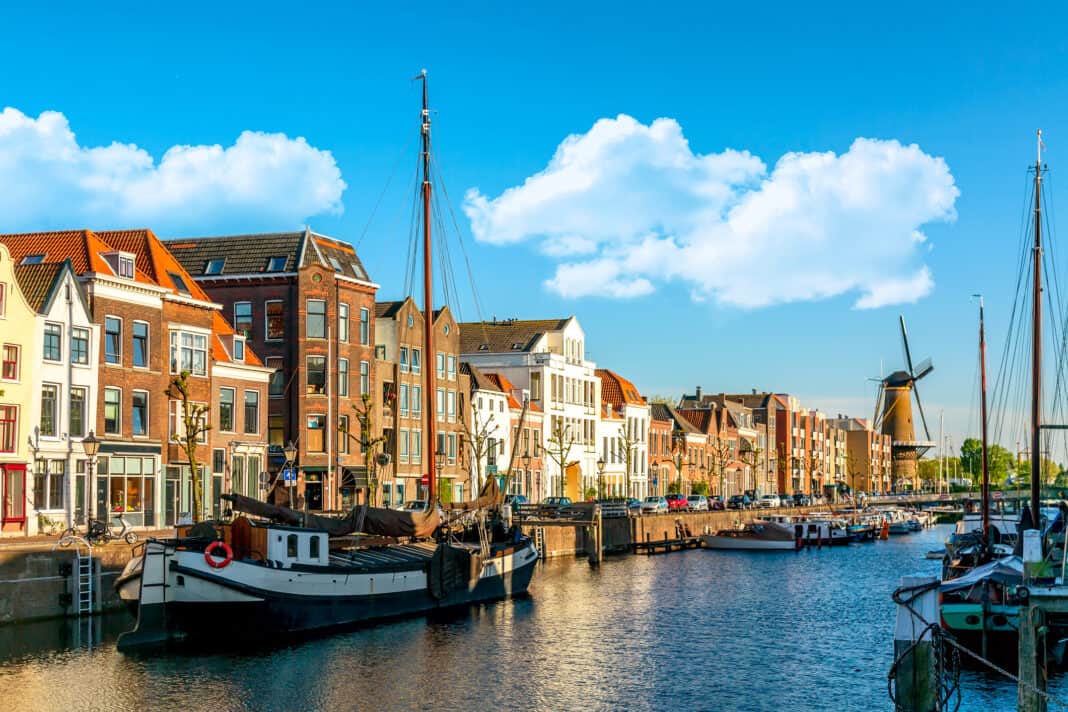
The Pilgrim Father’s Church is also in this area. It was the 17th-century meeting place of English pilgrims before they made their way to a new life across the Atlantic.
Another place to see some of the city’s old history is the St Laurenskerk church. This is the only medieval building left in the city. You can climb to the top to enjoy views of the city.
Unsurprisingly for Europe’s largest port, you can take a boat tour on the water.This gives you the chance to see the Erasmus Bridge, another modern structure called ‘the Swan’ by locals. The old harbour area also has several historic buildings, including the Witte Huis, a striking art nouveau building. It was apparently the tallest office building when it opened at the turn of the century.
If the city’s port history interests you, you can also visit the Maritime Museum Rotterdam. Other museums include the Museum Bojimans van Beuningen and the Kunsthal Museum, both art museums, and the Museum Rotterdam, which covers the history of the city.
After seeing some of the historical buildings and areas, you can move onto the more modern side of Rotterdam. Of note is the Overblaak Development. Here you can stare up at the famous yellow and white cube houses, which are luxury apartments.

A short walk away, you’ll find the Markthall (market hall). This is a massive horseshoe-shaped glass building, with a vast array of food stalls. You can time your visit with lunchtime and grab a snack here.
And if you’re looking for things to do in Rotterdam with children, the city has a zoo and Miniworld Rotterdam.
Verona, Italy
Another top city to visit in Italy is Verona. It is located in the north of the country, around 115 km to Venice and 155 km to Milan (both are less than 2 hours away by train, so you could also combine cities on a longer trip). It is also an ideal trip from resorts on nearby Lake Garda.
Verona is a really attractive medieval city. It is an easy place to walk around, as the top sights are located fairly close together.
Top of the list of things to do in Verona is a visit to the Arena, the city’s Roman amphitheatre. This is actually older than the Coliseum in Rome. It sits majestically in the centre of Piazza Bra.

It’s worth going into the Arena to see inside and get a sense of just how big it is (it can host concerts for up to 15,000 people). If you visit during the summer months, you can also book one of open-air opera performances that are held here.
Another must-see sight during your Verona city break is the Casa di Giulietta (Juliet’s Balcony), particularly if you are a lover of Shakespeare. It is said to be where Juliet – of ‘Romeo and Juliet’ fame – lived.
There is a bronze statue of her in the courtyard, a small museum, and you can gaze up at the famous balcony. My top tip, however, would be to get there early – it’s a popular place and can get very crowded with tourists.
Other places to head to include Piazza delle Erbe, a pretty square that is a perfect place for a stop for lunch or coffee. The Torre dei Lamberti, a 12th century Romanesque style tower you can climb, is here.
There’s also Castelvecchio, a small castle, and the Duomo by the river. If you wander along the river, you’ll come to the Ponte Pietra, the oldest bridge in the city.

You can also visit the Roman Theatre around here and climb to the Castel San Pietro perched on the hill. This castle is not spectacular in and of itself, but the views back across the city are.
Lugano, Switzerland
If you want a short break in a city with a real wow factor, put Lugano on your list. I visited for the first time last year and was blown away by its beauty.
Lugano is in the Italian part of Switzerland and just over an hour from Milan by train (a bit further from Zurich). It’s also near other places such as Locarno and Ascona, so it’s an excellent base for exploring the wider region.
The largest city in the Ticino region, Lugano sits on Lake Lugano and is surrounded by spectacular mountain scenery. After exploring the main centre with the Piazza della Riforma, which is lined with grand neoclassical buildings, you can wander down to the St Mary of the Angel church with its huge fresco inside.
Then, stroll along the lakeside promenade. You can look out across the water on the way to the funicular that will take you up the mountain to Monte San Salvatore.
In 12 minutes, the funicular takes you up to a height of over 900 metres to an area with absolutely incredible views. Get some of these from the restaurant’s outdoor terrace (you can see Lake Lugano and also over to Lake Maggiore in the distance) and then from the roof of the small church. From this part, you get amazing 360 degree views out across the area.

I’d also recommend taking a boat trip on Lake Lugano as part of your trip to Lugano. The journey out to Gandria, a tiny hamlet along the lake, is a worth it.

You can stop for lunch here, take a wander around the streets, and then walk back along the lake via the Olive Grove Trail. En route you can take the short diversion away from the lake and catch as second set of funiculars up to Monte Bre, another of the top Lugano attractions.
Lugano is a smaller city than some of the other places on my list here. But this makes it a perfect contrast to some city breaks where you’re rushing around trying to fit in seeing oodles of sights in a short space of time.
There’s enough here to keep you occupied for a few days and you can slow down, relax, and take in some outstanding scenery.
Other ideas for top Europe city breaks
The above is just a small snapshot of a vast range of European city breaks you can choose from. For other ideas, see my website.



